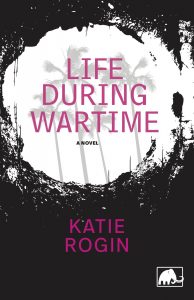Reviewed By Sarah Rosenthal

War means many things; for some people, it happens in dusty, far-off lands in camouflage and comes home in the form of valor-filled stories, shiny medals, and veteran ball caps. For others, it’s the daily prickle of loathing, addiction, or fear under your skin, begging you to give in. Still others see war in stateside streets: on drugs, on poverty, on gangs, on each other. No matter the perspective, after the dust settles, we are able to identify Before the war, when life was tipping closer to the edge every second; and After the war, the relief washing over with a tinge of regret. It’s the only way humans can process these events which take hold of our lives, shake them like a snowglobe, and leave us to pick up the pieces― learning from the Before, and appreciating the After.
In her debut novel Life During Wartime, Katie Rogin explores how we live in our 21st century wartime ― a wartime that has no beginning and no end (“He couldn’t shake this needling concern that war was everywhere, didn’t end or begin, even when you came home.”)
The novel spins the stories of several characters around the September 2008 disappearance of Nina Wicklow, a young veteran who has returned home to California from her recent tour of Iraq. Because the reader does not encounter Nina prior to her
disappearance, the other characters’ fuzzy relationships with Nina take precedence over a direct characterization of Nina herself ― solving her disappearance becomes the plot vehicle in which the other characters travel. Life During Wartime injects the reader into the middle of one of the worst decades in American history; as you’re flipping through the pages, the lines blur between fiction and reality because of the searing background noise of recovery from 9/11, continuing war overseas, and the shockwaves of the 2008 financial crisis. Each character is fighting their own battles in those wars and in wars inside their own minds, and Nina’s disappearance loosely connects these experiences of personal turmoil.
Rogin writes in a masterful third person close point of view which zones in on both major and minor characters, a quality likely carried over from her previous work as a screenwriter. Despite the unexpected intrusions of focus on minor characters, remarkably, the plot never jolts nor comes to screeching halts with each change of character focus; instead, the transitions are almost imperceptibly seamless, especially (and unconventionally) within the bounds of each chapter. This narrative style floats the story gently through the tumultuous situation, and allows each character’s experience of war to burn through the thick plot.
The strength and control of Rogin’s voice are perceptible on every level, syntactically, the skilled characterization is neat, simple, brief, and most often void of embellished language, allowing the reader to truly feel a character’s numbness in the midst of tragedy: “The canyon around her made nature noises and she wondered what was actually in the woods.” When figurative language or a rambling paragraph does show its face, it’s vivid and raw but still meticulous, and stops the reader to consider its impact (“As they fell onto the bed, Jim licked the alcohol from his wife’s tongue and listened to the ocean racing up the beach towards them,” and later, “The skin on her face gave off no moisture or color—it was solid pavement stretched like a mask across her features.”)
Beyond the book’s unique value as an example of well-executed, deliberate prose and characterization, it offers an important commentary on the shared experience of war. Each character has led a life of trauma, and despite all their individual circumstances, their stories converge here, together: “The world was ending. Not with the bang of a nuclear bomb, but with the whimpering bleat of an unanswered phone. Even if someone had answered the call, there would have been nothing on the other end.”
Due to the novel’s setting in 2008, knowing what obstacles have disturbed or will undoubtedly invade the characters’ lives makes their stories as individuals easier to accept, and shows how their distinct reactions to suffering find a common thread of understanding.
War is no single countdown ticking down, going off, and waiting to be reset. War, in any sense of the experience, is always everywhere, silent alarms screaming in a million places. There is no Before, and there certainly is no After. Life During Wartime raises questions about coping and recovery as a whole, and ultimately beautifully demonstrates that the goal is acceptance ― acceptance not only that war is inevitable, but also that it is shared.
